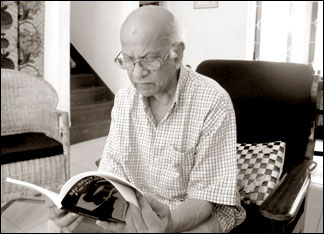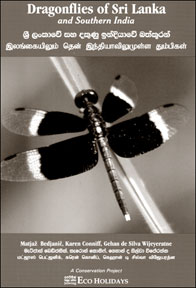
The poet who dared
by Aditha Dissanayake
Revolting against all conventions; the rules of rhythm, meter and
ornamental language Professor Siri Gunasinghe introduced free verse into
Sinhala poetry, for the first time in the history of our literature.
|

Professor Siri Gunasinghe |
His collection of poems "Mas le nathi ata" was published way back in
1956. Today almost five decades later, back in his motherland on a short
vacation, Professor Gunasnghe makes a wish when I meet him at his
brother's home in Nawala. He hopes no one will throw bricks at him after
reading this article.
Yet, even though he might get hit with boulders (when he really
should get bouquets) he is brave enough to say "We are not the most
civilized people in the world, even though we think we are. On the
contrary we are somewhere at the bottom of the line".
He attributes this way of thinking of his countrymen to an obsession
with a two thousand year old culture. "Culture is what you feel for, in
terms of what you see" So culture is something expressed through
material things.
"This is culture" he says pointing at the chairs, the picture of a
bunch of roses on the wall, the potted plant beside him, none of which
has got anything to do with our 2500 year old culture. Professor
Gunasinghe feels that this is something we have to accept, that things
have changed during the past two thousand years and that until we
realize this fact we will never move forward.
Things ought to change. Sooner the better. Even simple things like
removing your shoes before entering the precincts of a temple. "I rarely
go to a temple even though I would love to sit in front of a bo tree and
meditate" explains Professor Gunasinghe. "I don't go because when I walk
on pebbles I collapse".
Speaking on behalf of many who face similar difficulties Professor
Gunasinghe says this is a residue of feudal culture which ought to be
eliminated. He blames intellectuals and politicians alike for refusing
to recognize the necessity of making these changes.
This was exactly why there had been objections when he started to
write in free-verse in 1956. No other collection of poetry had created
such an up-roar in the arena of Sri Lankan literature in the past or is
likely to do so in the future.
Quite unperturbed about this revolution, which he brought forth
single-handedly, for the only other writer to have written in a similar
style G.B Senanayake had confessed his work was neither prose nor verse,
Prof Gunasinghe admits he was influenced by Western literature of which
he was and still is an avid reader.
Guided by a wonderful young teacher, fresh out of the University of
Peradeniya, who taught him when he was a student of Mahinda College,
Galle, Professor Gunasinghe says he would have been influenced by
English and French poets, and by the likes of Pablo Neruda, Gracia Lorca
etc.
He feels those who found fault with his free verse were those who
disliked English and everything connected with the West. He dismisses
poetry of the 50s as "superficial and meaningless".
Reading them was a total waste of time, even though they sounded nice
because of their musical quality". Thus in 'Mas le nathi ata' he infuses
Sinhala poetry with emotions never touched upon, before.
He makes the night squirm through the window, while the wind barks
like a dog and the headlines of a newspaper jump up and down, laughing
in black and white.
The way to go, is ahead. "Why must we go back?" asks Professor
Gunasinghe in conclusion.
"There is an open door in front of you, why turn your back on it?"
[email protected]
View through a clear glass
by Maureen Seneviratne

Title : The Sweet and Simple Kind
Author: Yasmine Gooneratne
|
Yasmine Gooneratne's long, absorbing novel is a colourful,
intricately patterned tapestry of a time not so long ago in the count of
years: an age of elegance, an era which can never again be so finely
drawn in the vortex of rapid, socio-cultural changes that are sweeping
through society.
Her tapestry is vivid, at once illuminated by the light of humour and
shadowed by the sombre, blood-dark that had already loomed on the
horizon.
For someone like myself, who has lived through the greater part of
the time-frame covered by this novel, it is a nostalgic read.
Whether of the same socio-economic status as the key characters in
the story or not, the cultural outlook of all who were afforded the
distinct advantages of an English education in the "Secondary Schools"
was similar.
One is reminded by this book that even those who engineered the
changes, or spoke in fiery terms of liberty, equality and fraternity
were heirs to that same tradition, had been educated in those same
schools and universities here and abroad.
The author masterfully captures the ethos of those times, and
presents a thousand questions that a discerning reader might ask; not
least that key question as to how those "lost" years fled away from each
of us, years that are now but a mottled memory.
What comes through to the reader is the author's significant ability
to have seen through the glass clearly, and described the way of life,
the behavioural patterns if one might say so, of a certain segment of
society in those pre- and postcolonial years; the ones who gained (in
diverse, even questionable ways) position, privilege and money; those
belonging to a clan that was "*Westernized by background and education
to the point at which some branches of it seemed more British than the
British themselves."
She exposes the sham and hypocrisy which it was the fashion then,
even more so than now, to cover up.
Nowhere is Yasmine Gooneratne's book a mere document of a particular
socio-political period, covering the last days of colonial rule and the
first two decades after political independence was granted to what
seemed to be an amiable and spirited people.
She has written a novel; and such is her skill and ability to
re-create through character, incident and literary devices every nuance
of that time much of it unrecognizable to most people under fifty years
of age that the tale she unfolds is one of the finest fictional examples
I have ever come across of that brief, vibrant period of our history.
Those were years that have left lasting scars on a society that was
even then being intensively politicized; which was unequal in structure;
where the poor and underprivileged were still being marginalized; and
where caste and status still held undisputed sway.
The novel begins with a dramatic incident, the discovery of the body
of Lady Alexandra Millbank, wife of the British Governor of the time,
spreadeagled on the paved pathway of the Residency.
Has she accidentally fallen from her upstairs window, has she
committed suicide, or has she been pushed? She has died on the morning
of the very day that a special reception is to be held at the Residency
for the visiting Prince of Wales, heir to the British crown.
Dogs bark when the circumstances of her death become publicly known,
but the caravan moves on. The mystery is never cleared up, and the
Governor, Sir Andrew, finds it wise to flee from local gossip. Retiring
in haste, he makes as soon as he decently can, for "the safety of the
British Isles".
This episode draws the reader's attention to the social codes and
niceties which existed at the time (the mid-1930s), and to the attitude
of the ruling white elite to the "natives" - even if these same
"natives" were wealthy and well educated, holding high positions in the
innermost circles of Government that they had gained by serving their
white masters dutifully and with zeal for several generations.
The tale that is told in such depth of detail, mirroring an "age",
centres on the immediate and extended family of Rowland Wijesinha,
Governor Millbank's only "native" ADC.
Rowland is "*very wealthy in his own right, being the owner of
inherited estates, and possessing the height, bearing and impressive
profile that is often associated in the popular mind with aristocracy".
The connection between Rowland and the Millbank affair is that later,
when the house goes up for sale, it is purchased by his grandfather, Don
Jeronis Wijesinha, and begins a new existence as the Wijesinhas'
"country house".
The novel's main concern is with Rowland's younger daughter Tsunami
and her second cousin, Latha, their long association, and the close
kinship that comes to exist between these two totally different
personalities. They must adapt, as they grow up, to life in a country in
which the social scenario is undergoing rapid change.
Their outlook is very different from that of their common forebear,
Don Jeronis Wijesinha of three generations before, or even of their own
parents.
And yet, as the author brilliantly leads her readers to understand,
eventually and generally like turns to like (or as nearly like as
possible), finding comfort in a "same-ness" that is extraordinarily
binding.
In spite of the several layers of life to which Tsunami and Latha are
exposed, in spite of the larger and more varied aspects and facets of
life they themselves experience (compared to the smaller, more
restricted canvases of their own inner circles), in the end their own
choices are very typical of their background.
It is impossible to convey in a brief review how cleverly the author
conducts her characters through a maze of circumstances, through doors
that open to them which were closed to young women of their background
in earlier years, despite their advantages of wealth and status.
A sense of graphic realism is evoked that is strangely, startlingly
accurate. It is a reality that is hard to take. "Human kind cannot bear
very much reality", says the narrator, aptly quoting Eliot at one of the
novel's crucial moments, as murderous mobs rampage through the streets
during the Emergency of 1958. Yet there is no labouring on the author's
part to achieve her effects and develop her theme.
A few strokes of deft brush work here and there reveal much more than
would many pages of narration and description. I select but one: the
novel's portrait of Helen Wijesinha, the beautiful talented young Indian
painter who meets and marries Rowland, that man of verve and drive and
intense ambition, on a trip he makes to India in his youth; Helen, the
mother of vivacious, outspoken, scintillating Tsunami; Helen, and the
embroidered table cloth which becomes "a cons*tant element in (her)
life".
Helen is the chatelaine of Lucas Falls, the country home of the
Wijesinha family, a stately mansion (formerly a Residency) set in the
midst of a flourishing tea plantation. She is a woman who cherishes and
guards her privacy.
She appears to be a woman of quiet and gentle ways who habitually
defers to her husband; but there is an adamantine streak in her nature.
She is, in her way, a loving mother; but first and foremost she is an
artist, possessing a soul and fingers that create beauty, even if her
creations are not to the taste of the brusque and insensitive Moira,
Rowland's aggressive cousin.
We read of Helen's uneasy relationship with her husband and his
family, and see it reflected in the exquisitely elaborate piece of
embroidery that she was never able to complete: like life itself, in
which it takes years to grow physically, mentally, and emotionally from
childhood to womanhood.
Continued next week...
Splendour's of nature
Dragonflies of Sri Lanka and Southern India:
by Rosanne Koelmeyer Anderson
The photography guide on the Dragonflies of Sri Lanka and Southern
India compiled by Gehan de Silva Wijeratne with the assistance of Karen
Conniff and Matjaz Bedjanic is a multihued compilation of infinite
beauty of the wild.
 An insight into the magnificence of Sri Lanka's species of
dragonflies and damselflies, the booklet is a fine guide for nature
lovers photographic identification guide to the fauna and flora of Sri
Lanka, a first step towards enabling people to put a name to a species. An insight into the magnificence of Sri Lanka's species of
dragonflies and damselflies, the booklet is a fine guide for nature
lovers photographic identification guide to the fauna and flora of Sri
Lanka, a first step towards enabling people to put a name to a species.
The booklet contains photographs of 78 of the 118 described species
of dragonflies and damselflies found in Sri Lanka with the inclusion of
photographs of both male and female forms, which can be very different
from each other.
The names of species names are in English and have been transcribed
into Sinhala and Tamil. In Sri Lanka in the local languages we have only
one word for "dragonfly" despite having 118 species of dragonflies and
damselflies.
The wildlife enthusiast photographer's says the idea behind this book
is to awaken people to the richness of Sri Lankan wildlife and to create
a personal connection between them, wildlife conservation and nurturing
biodiversity.
The photographer's mission is to create a million wildlife
enthusiasts in Sri Lanka by the year 2025. An Engineering graduate of
Imperial College and qualified Chartered Accountant with Deloittes
Touche Tohmatsu he worked at LIFFE, Sumitomo Finance International and
Abbey National, London for fifteen years before returning to Sri Lanka.
Gehan has lead, authored and photographed several books on wildlife
including popular anthologies like. A Bird watchers Guide to Sri Lanka,
Magic of Sri Lanka and the Portrait of Sri Lanka.
Karen Conniff on the other hand says she enjoys observing and
documenting dragonflies and damselflies in Sri Lanka as she has indulged
in something close to her heart for many years, collecting insects and
observing them.
With a PhD in Agricultural Science she has even taught basic
Entomology to agriculture students in Lesotho, Africa and trained
farmers in Nepal on the use of pesticides and began a pesticide
residue-testing programme in Nepal.
Matjaz Bedjanic whose interests are taxonomy, biology, zoogeography
and protection of dragonflies in South East Asia especially Sri Lanka,
nature protection of freshwater ecosystems, fieldwork and nature
photography is a graduate in Biology whose thesis was on.
An attempt of the analysis of the dragonfly fauna of Sri Lanka.
Matjaz was employed at the Institute for Nature Conservation of the
Republic of Slovenia where he worked on the protection of animal species
and their habitats.
[email protected]
|
